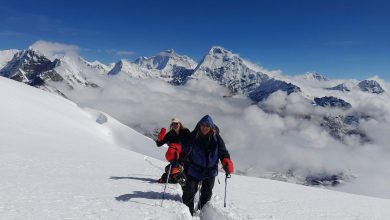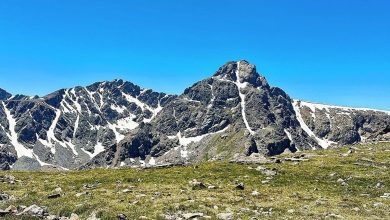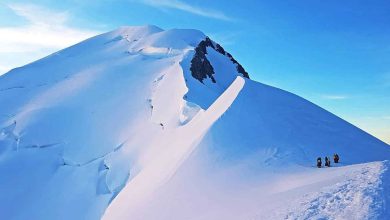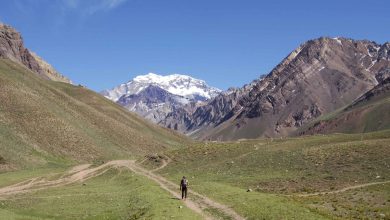Mount Nuptse: Mountain That Most Trekkers Misidentify As Everest
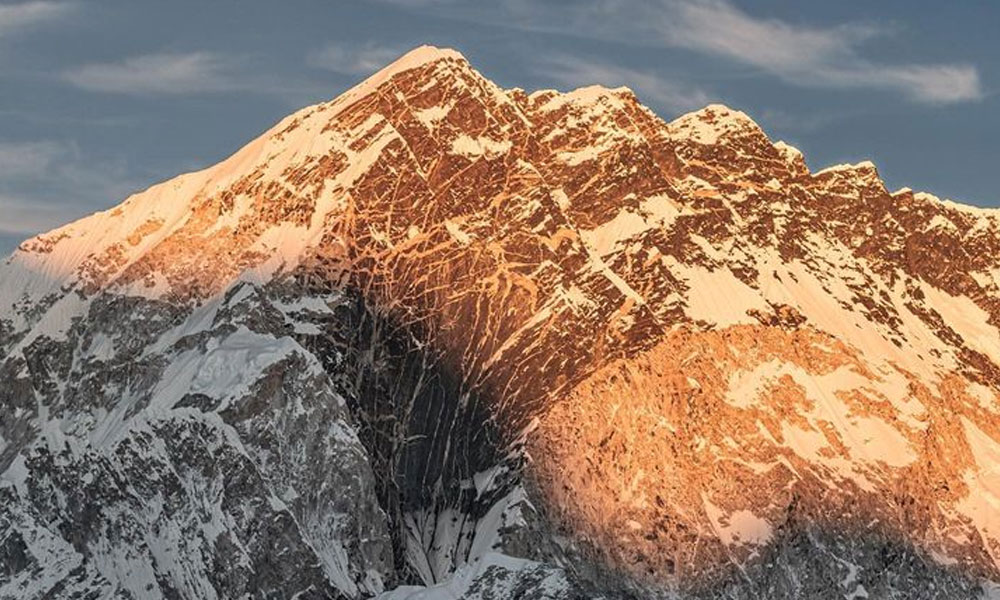
Region: Khumbu Region
Starting Point: The treks to Nuptse typically start from Lukla, which is a common starting point for many treks in the Everest region.
Distance: The distance to Nuptse can vary depending on the specific route and itinerary chosen, but it’s often included as part of the Everest Base Camp trek. The distance to Nuptse from Lukla would be similar to that of Everest Base Camp, which is approximately 38.58 kilometers (24 miles) from Lukla.
Duration: The duration of the trek to Nuptse would depend on your specific itinerary and pace. If you’re trekking as part of an Everest Base Camp trek, it usually takes around 12 to 14 days to complete.
Altitude: Nuptse itself is a challenging climb and reaches an altitude of 7,861 meters (25,791 feet).
Nearest Landmark: Nuptse offers stunning views along the Everest Base Camp trek, including a close-up view of the Khumbu Glacier and the famous Khumbu Icefall, which is the route to Mount Everest for climbers. You can also enjoy panoramic views of Nuptse from various points along the trail.
Best Time: The best time to trek to Nuptse, as with the Everest region in general, is during the spring (March to May) and autumn (September to November) when the weather is relatively stable, and the skies are clear.
Permits: To trek in the Everest region, you will need two main permits: the Sagarmatha National Park Entry Permit and the Khumbu Pasang Lhamu Rural Municipality Entrance Permit. These permits are essential for both Nuptse and the Everest Base Camp trek.
Treks Related to the Mountain: Nuptse is often included as part of the Everest Base Camp trek, which is one of the most popular treks in the Khumbu region. While the primary goal of the Everest Base Camp trek is to reach the base camp of Mount Everest, you’ll have the opportunity to admire Nuptse’s impressive presence along the way.
Nuptse is a really tall mountain near Mount Everest in Nepal. It’s in the Khumbu region and stands at a whopping 7,861 meters (25,791 feet). Nuptse is famous because you can see it on the way to Everest Base Camp. People who trek or climb there get to see this big mountain up close. It’s close to Mount Everest and the tricky Khumbu Icefall, which makes it even more special. Nuptse adds to the natural beauty of the area, and it’s a big part of the famous Everest region in the Himalayas.
A Common Confusion Among Trekkers

Trekkers often get Mount Nuptse mixed up with Mount Everest while on their journey. These two mountains are very close and both look incredibly massive. So, on the way to Everest Base Camp, folks can mistake Nuptse for Everest. But later, they realize that Everest is still further ahead.
The Beauty Of Mount Nuptse
Nuptse, the mountain neighbor of Mount Everest, is a sight to behold when you’re out trekking in the Khumbu region. It might not be the tallest, but it’s incredibly captivating.
What really makes Nuptse beautiful is where it sits. It’s like a precious jewel in a mountain family, with other stunning peaks and the amazing Khumbu Glacier all around. As the day goes by, the sunlight makes Nuptse look different, like a constantly changing painting by nature.
Distinguish between Mount Everest and Mount Nuptse
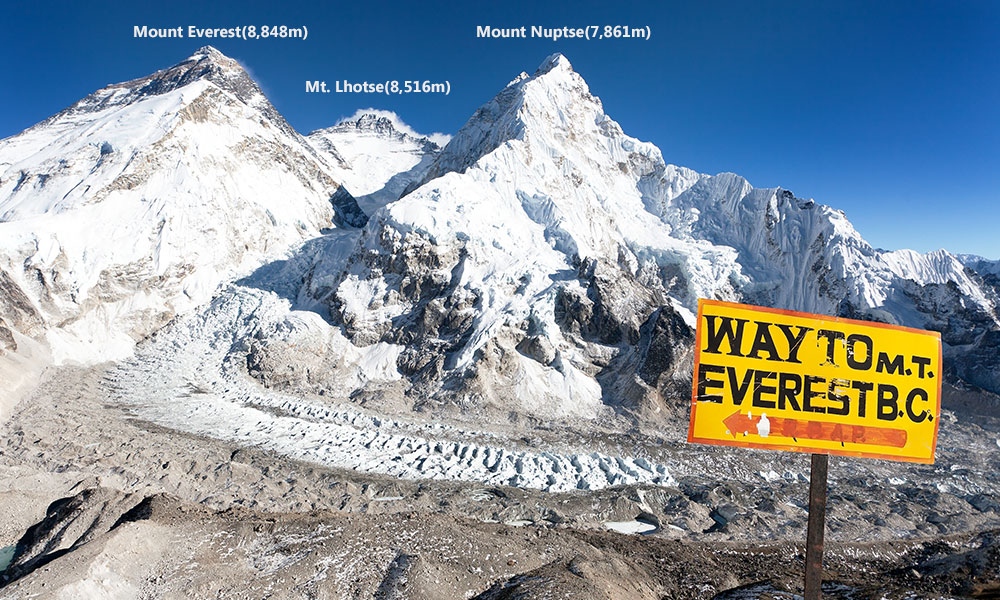
Distinguishing between Mount Everest and Mount Nuptse on a trek can be a bit tricky because they’re really close and kind of look alike. But there are some simple ways to tell them apart. First, Everest is taller and pointier, while Nuptse looks flatter and has jagged edges on top. Also, if you’re on the usual Everest Base Camp trail, Everest is a bit to the left, and Nuptse is on the right side. Everest usually has more snow and ice on it, while Nuptse can look rockier. Remembering these things can help you figure out which mountain is which while you’re on your adventure.
Culture and Communities
In the Khumbu region, where Mount Nuptse stands tall, it’s not just about the mountains; it’s about the amazing Sherpa culture too. These folks, deeply tied to these rugged heights, are some of the friendliest people you’ll ever meet. They bring their ancient traditions to life with colorful flags, prayers, and incredible festivals like Mani Rimdu. And oh, don’t miss their delicious momo and warm yak butter tea! Staying in their cozy teahouses and hearing their incredible mountain tales will make your adventure more than just a trek—it’s a cultural journey.
Natural flora and Fauna
On Mount Nuptse, where it’s super high up, the plants are like real survivors. There are these strong, short plants and mosses that somehow handle the tough conditions. And when summer rolls in for a little while, some cool alpine flowers pop up, making the rocky place look all colorful. But if you look around, you’ll see that Mount Nuptse doesn’t have as many types of plants as the lower areas. It’s pretty sparse up there when it comes to green stuff.
On Mount Nuptse, the animal kingdom takes on a specialized role due to the extreme elevation and conditions. Among them is the Himalayan tahr, resembling a mountain goat, and the Himalayan pika, somewhat akin to a mountain-dwelling rabbit. In the skies above, keen-eyed observers may spot Himalayan snowcocks and various species of vultures gracefully navigating the rarified air. However, given the high-altitude environment, the diversity of animal species is notably less compared to lower altitudes.
Reaching there
Reaching Mount Nuptse, homed in Nepal’s Khumbu region, is a thrilling journey that welcomes both domestic and international tourists. Here’s a step-by-step guide to help you plan your adventure:
Obtaining permits
Before embarking on your trek to Mount Nuptse, ensure you have the necessary permits. International tourists will require a Sagarmatha National Park Entry Permit, while domestic tourists need to obtain a TIMS (Trekkers’ Information Management System) card. You can obtain these permits in Kathmandu or at the entry point to the park.
Getting to Lukla
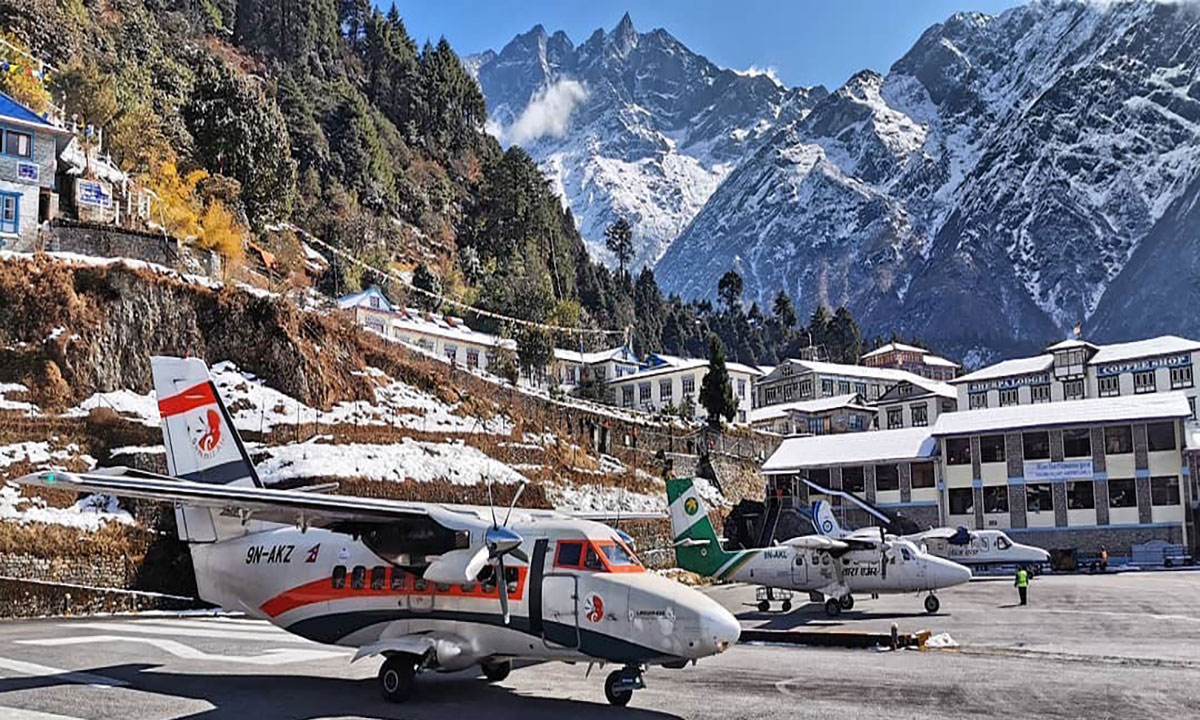
To reach the Everest region, book a flight from Kathmandu to Lukla. Lukla’s Tenzing-Hillary Airport is the gateway to the Khumbu region. Domestic airlines operate daily flights, but weather conditions can affect schedules, so it’s wise to plan some flexibility into your itinerary.
Note : While flight is the easiest way to reach there , some roadways are also available from different parts of Nepal.
Trekking to Namche Bazar
Upon landing in Lukla, start your trek towards Namche Bazaar, a bustling town and the primary trading hub in the region. The trek to Namche typically takes two days, with an overnight stay in Phakding. It’s essential to acclimatize gradually to the increasing altitude.
Acclimatizing at Namche
Spend at least one day in Namche for acclimatization. You can explore the town, visit the Sagarmatha National Park Visitor Center, and enjoy panoramic views of Everest and Nuptse from the nearby viewpoints.
Trek to Gokyo
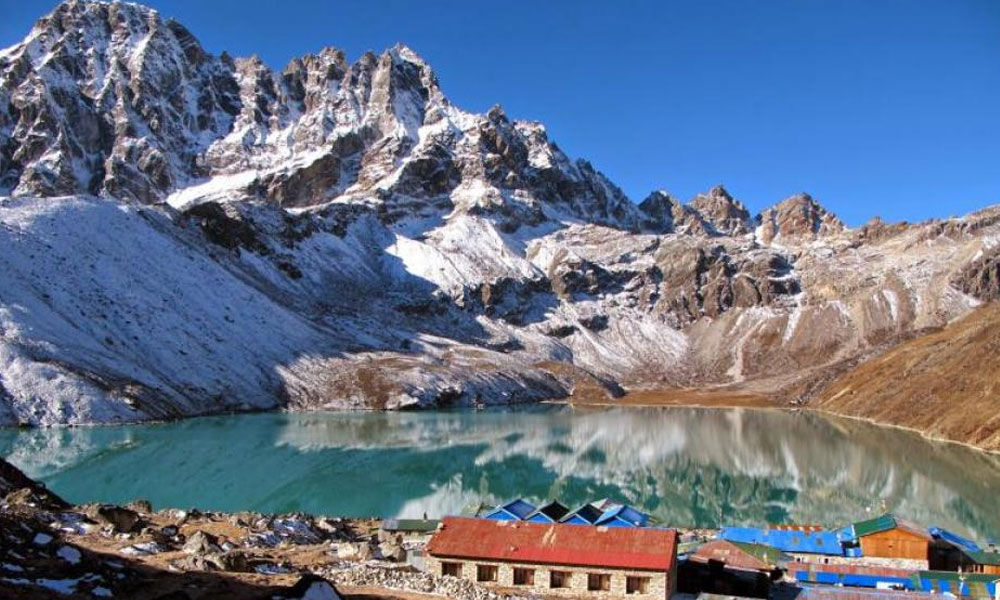
To get even closer to the awe-inspiring Mount Nuptse, the plan is to head over to the lovely Gokyo Valley. It’s like stepping into a postcard with its stunning scenery. Along the way, you’ll pass through charming Sherpa villages like Khumjung and Dole. These places aren’t just dots on the map; they’re spots where you can really get a feel for Sherpa culture and the warm, welcoming vibes of the locals.
But the best part of this adventure is the eye candy. Seriously, it’s like a non-stop show of breathtaking mountain views. Each twist and turn on the trail reveals another gorgeous peak, and they all seem to be trying to outdo each other in the beauty department. And all of this is leading you right to the spectacular Mount Nuptse.
Final leg to Mount Nuptse
Continue your trek from Gokyo towards Mount Nuptse. The trek is a bit challenging, but the views of Nuptse and neighboring peaks make it incredibly rewarding. Remember to follow the recommended acclimatization guidelines to avoid altitude sickness.
Climbing up the terrain
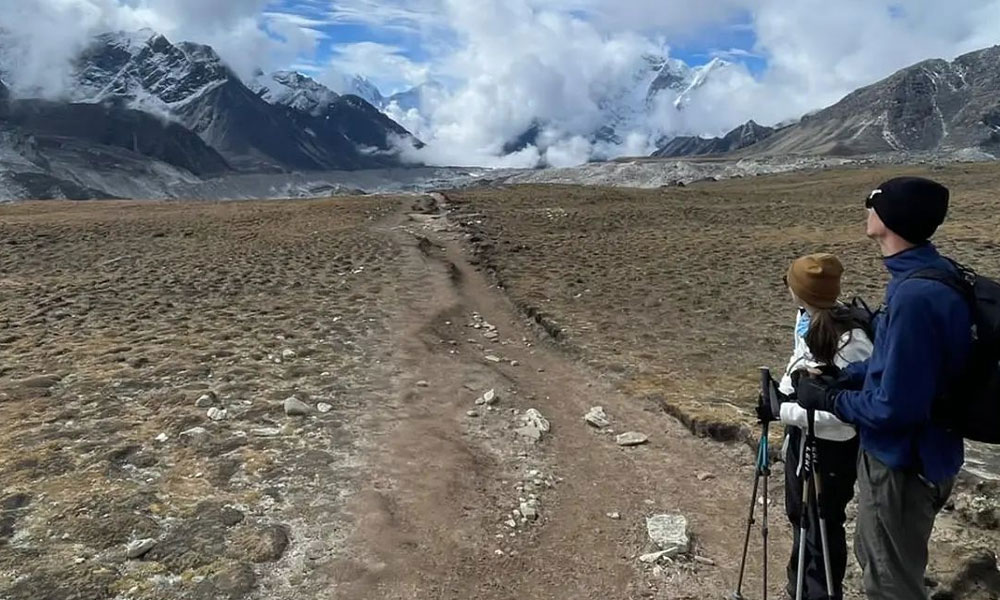
Climbing up Mount Nuptse involves tackling some really tough terrain. Here’s what it’s like:
Steep sections
Picture this: you’re facing steep slopes that seem to rise forever. These parts of the climb demand serious effort. It’s like climbing a never-ending staircase, but instead of steps, you’ve got to find your way on icy surfaces. This is where your climbing skills and gear, like crampons and ice axes, really come into play. They’re your allies in maintaining your grip and balance.
Navigating Icy Challenges
Mount Nuptse doesn’t hold back on the ice. It’s like Mother Nature’s ice rink up there. You’ve got to know how to deal with it. Ice climbing techniques become your best friends. Specialized gear, designed to bite into icy surfaces, helps you stay steady. It’s like dancing on ice, but with crampons and ropes.
Technical Knowledge
Climbing Nuptse isn’t just about going up; it’s about mastering glacier travel and ice climbing. Imagine crossing deep crevasses, sometimes spanning several meters. You’ve got to know how to secure yourself with ropes and harnesses. It’s like being your own safety net.
Adapting to the terrain
Climbing Mount Nuptse is like embarking on a journey full of surprises. Just when you get comfortable on rocky terrain, you find yourself in what feels like a frozen world. It’s as if the mountain keeps switching the challenges on you, like a series of puzzles to solve on the same path.
Imagine it’s a bit like a hike that takes you from a rugged, rocky trail to an icy wonderland in the blink of an eye. Each step becomes a mini-adventure, requiring you to carefully consider where to place your foot and use your climbing skills to stay surefooted.
So, it’s not just about physical endurance; it’s also about mental agility. You’ve got to adapt quickly to these changing landscapes, like switching gears in a thrilling adventure, all while inching closer to that elusive summit.
Challenging Weather
Now, imagine all of this while dealing with unpredictable mountain weather. It might suddenly snow heavily, the wind could howl, and visibility might drop. It’s like playing a game of weather roulette. You have to stay vigilant, watch the forecast, and make decisions to keep everyone safe.
As trekkers stand at the top of Mt Nuptse, looking at the beautiful panorama of Nepal, a sense of accomplishment hits with the majestic surroundings. This journey is filled with a rugged adventure and sacred landscapes.
View this post on Instagram
You may also like:
